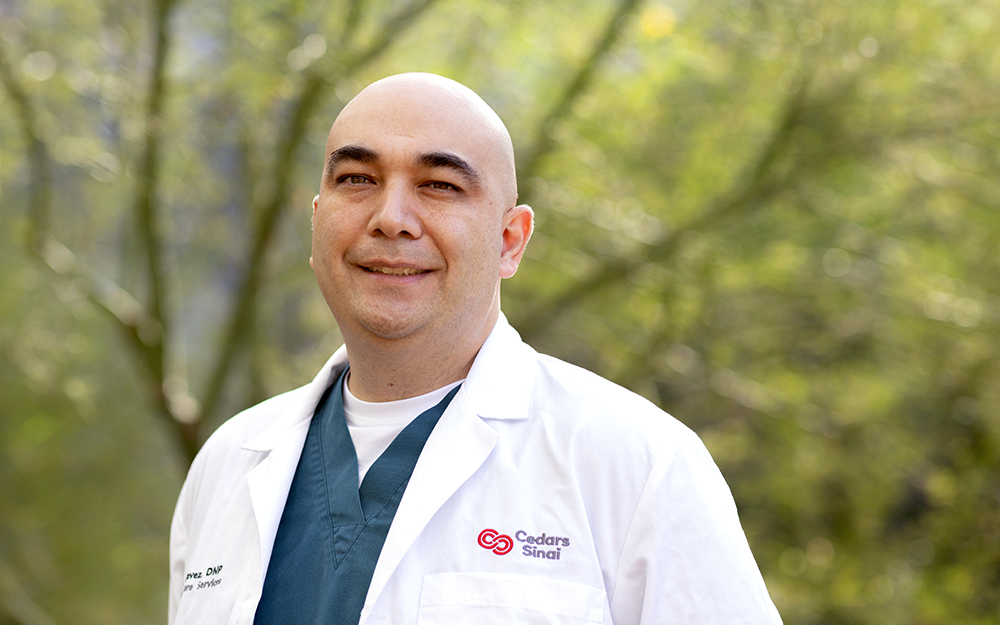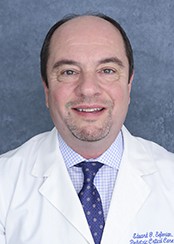Cedars-Sinai Blog
Small Change, Big Impact For Pilot Program Led By ICU Nurses
Nov 02, 2022 Jasmine Aimaq

Critical care nurse Jose Chavez led a team of ICU nurses to create a pilot program that was crucial to conserving personal protective equipment (PPE) during the COVID-19 pandemic.
Many people know nurses as kind and efficient professionals who take care of you at the bedside. Less well known is the incredible role they play behind the scenes at hospitals, using creativity, collaboration and leadership to solve problems few of us think about.
"There are many serious considerations when you change something that is always done the same way. Our utmost priority was the wellbeing of our patients."
Warning signs
When the COVID-19 pandemic arrived in spring 2020, healthcare facilities found themselves facing problems no one expected. Nationwide, there was not enough personal protective equipment (PPE) for all the healthcare workers who needed it.
"We started hearing that facilities were running out of N95 respirators, gowns and gloves and that manufacturers couldn’t keep up," says Jose Chavez, a critical care nurse in Cedars-Sinai’s intensive care unit (ICU).
"There were no precedents," he recalls. "We couldn’t just see what had been done before and do the same thing."
Jose and his colleagues also were dealing with the uncertainty that surrounded COVID-19 in the early days.
"People weren’t totally sure which protective equipment was optimal," he says.
Thanks to its Special Pathogens Response Team—one of only a few in the nation—Cedars-Sinai knows how to deal with infection control. Hospital leaders quickly put in place methods to stop the spread of SARS-CoV-2, the virus that causes COVID-19.
"This was very effective, but it created a new dilemma in the ICU," says Jose.
Here’s why: ICU patients need round-the-clock attention, but pandemic infection-control protocols required nurses to put on full PPE every time they entered a patient’s room for any reason.
"I'd put on a clean gown, gloves, face shield and N95 respirator," Jose recalls. "I would go in, check on my patient and complete my task."
Afterward, he would walk out, close the door and promptly discard his PPE as required.
"Then, I would suddenly hear beeping from inside the room that indicated one of the medications unexpectedly had to be checked or adjusted," he says.
So, Jose would have to put on fresh PPE just moments after changing out of his previous set of PPE.
In Discoveries: What Did COVID-19 Teach Us for the Next Pandemic?
Safety in numbers
That wasn’t all. Many drugs used in the ICU must be double-checked by a second nurse. This policy keeps patients safe by making extra-sure the right drug is being given at the right time and the right dose. It also means another set of PPE coming on and off in a short amount of time.
If two nurses go through the process of administering a medication and then have to do the same thing again with another drug soon after, they might use four full sets of PPE in just a few minutes.
"With every nurse doing this on the floor many times each day, you can imagine how much PPE we were going through," says Jose.
Double whammy
Additionally, there were concerns about how contagious SARS-CoV-2 might be.
"In spring 2020, we were seeing more and more patients with COVID-19 in the ICU," Jose says.
Some patients were hospitalized because COVID-19 had made them very sick, while others were admitted for a different condition but happened to be infected with SARS-CoV-2.
Nurses, doctors, custodial staff and others who worked in healthcare facilities had to protect themselves while making sure they were doing their best for patients.
"If we got sick, we wouldn't be able to help anybody, so it was very important to avoid getting infected," Jose says.
He notes that ICUs were faced with a double whammy: What if hospitals ran out of PPE and nurses got heavily exposed to SARS-CoV-2?
Simple but not easy
Jose’s team came up with an idea that helped solve both problems.
The ICU nurses proposed a pilot program under the direction of Dr. Edward Seferian, chief patient safety officer at Cedars-Sinai. The pilot would move the intravenous (IV) pumps outside the patient’s room. That way, nurses could monitor and adjust the patient’s medications without entering the room.

Edward G. Seferian, MD
The idea was groundbreakingly simple. But simple doesn’t always mean easy.
"It's not as easy as just moving the equipment out of the patient’s room," Jose explains. "There are many serious considerations when you change something that is always done the same way. Our utmost priority was the wellbeing of our patients."
One key question was whether the medication would flow smoothly through longer tubing and reach the patient as quickly as it needed to. The nurses consulted with doctors and engaged every department whose help and expertise they would need. That included infection-control specialists, regulatory experts, facilities management, supply chain professionals and patient safety leaders.
The nurses and the pilot
After a careful analysis, the pilot program was launched, and the IV pumps were moved outside the doors to patients’ rooms.
The distance was small, but the impact was big. So big, in fact, that Jose’s team presented the results of the pilot at nursing conferences, which led other healthcare organizations to introduce the change, as well.
Cedars-Sinai ICU nurses helped conserve precious PPE in those early, uncertain days of the pandemic. They also reduced the risk of infection for staff and patients alike, and they modeled the Cedars-Sinai values of collaborating across departments and empowering employees.


